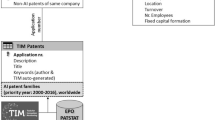Abstract
This paper analyzes the productivity challenges as well as the production-related technological investments in the U.S. manufacturing sector in order to create a rich framework for productivity-enhancing policy making. It offers an industry-based analysis of the evolution of manufacturing productivity performance and subsequently presents original, survey-generated data on automation investment. Productivity performance drivers are statistically identified and a discussion of the still poorly understood relationship between automation and productivity is offered.

Source(s): U.S. Bureau of Labor Statistics.

Source(s): U.S. Bureau of Labor Statistics.

Source(s): U.S. Bureau of Labor Statistics.

Source(s): U.S. Bureau of Labor Statistics.

Source(s): U.S. Bureau of Labor Statistics.

Source(s): U.S. Bureau of Labor Statistics and MAPI Foundation.

Source(s): MAPI Foundation.

Source(s): MAPI Foundation.

Source(s): MAPI Foundation.

Source(s): MAPI Foundation.

Source(s): MAPI Foundation.

Source(s): MAPI Foundation.

Source(s): MAPI Foundation.

Source(s): MAPI Foundation.

Source(s): MAPI Foundation.

Source(s): MAPI Foundation.

Source(s): MAPI Foundation.
Similar content being viewed by others
Notes
After most recessions, output recovers before employment, creating an arithmetic bounce in labor productivity growth that is not necessarily indicative of a significant shift.
For certain parameters, a number of sectors are combined, making for less than 21.
Significance has a descending scale. A lower number indicates superior statistical significance.
See for example, Diego Comin and Bart Hobijn [2007].
References
Bernanke, Ben S. 1981. The Sources of Labor Productivity Variation in U.S. Manufacturing, 1947–1980. National Bureau of Economic Research Working Paper 712.
Comin, Diego and Bart Hobijn. 2007. Implementing Technology. National Bureau of Economic Research Working Paper 12886.
Eichengreen, Barry, Donghyan Park and Kwanho Shin. 2015. The Global Productivity Slump. National Bureau of Economic Research Working Paper 21556.
Jorgenson, Dale, Mun S. Ho, Kevin J. Stiroh and Kevin J. 2008. “A Retrospective Look at the U.S. Productivity Growth Resurgence,” Journal of Economic Perspectives, 22(1): 3–24.
Leonard, Jeremy and Cliff Waldman. 2007. “An Empirical Model of the Sources of Innovation in the U.S. Manufacturing Sector,” Business Economics, 42(4): 33–45.
Steindel, Charles. 1992. “Manufacturing Productivity and High-Tech Investment,” Federal Reserve Bank of New York Quarterly Review, 17(2): 39–47.
Stiroh, Kevin J. 2001. “What Drives Productivity Growth?,” Federal Reserve Bank of New York Economic Policy Review, 7(1): 37–59.
Syverson, Chad. 2004. “Product Substitutability and Productivity Dispersion.” Journal of Industrial Economics, 55(2): 534–550.
Syverson, Chad, 2011. “What Determines Productivity?” Journal of Economic Literature, 49(2): 326–365.
Acknowledgements
The author gratefully acknowleges funding support from MAPI member Rockwell Automation. He benefitted from comments on earlier drafts by Stephen Gold, President and CEO of MAPI and Dan Meckstroth, Vice President and Chief Economist of MAPI. The author is grateful for excellent copy editing by MAPI Editor Andrea Goodwin and excellent layout assistance by MAPI Content Marketing Specialist Karyn Hill.
Author information
Authors and Affiliations
Corresponding author
Rights and permissions
About this article
Cite this article
Waldman, C. The Evolving Contours of Productivity Performance and Automation Investment in U.S. Manufacturing. Bus Econ 51, 213–238 (2016). https://doi.org/10.1057/s11369-016-0013-1
Published:
Issue Date:
DOI: https://doi.org/10.1057/s11369-016-0013-1




